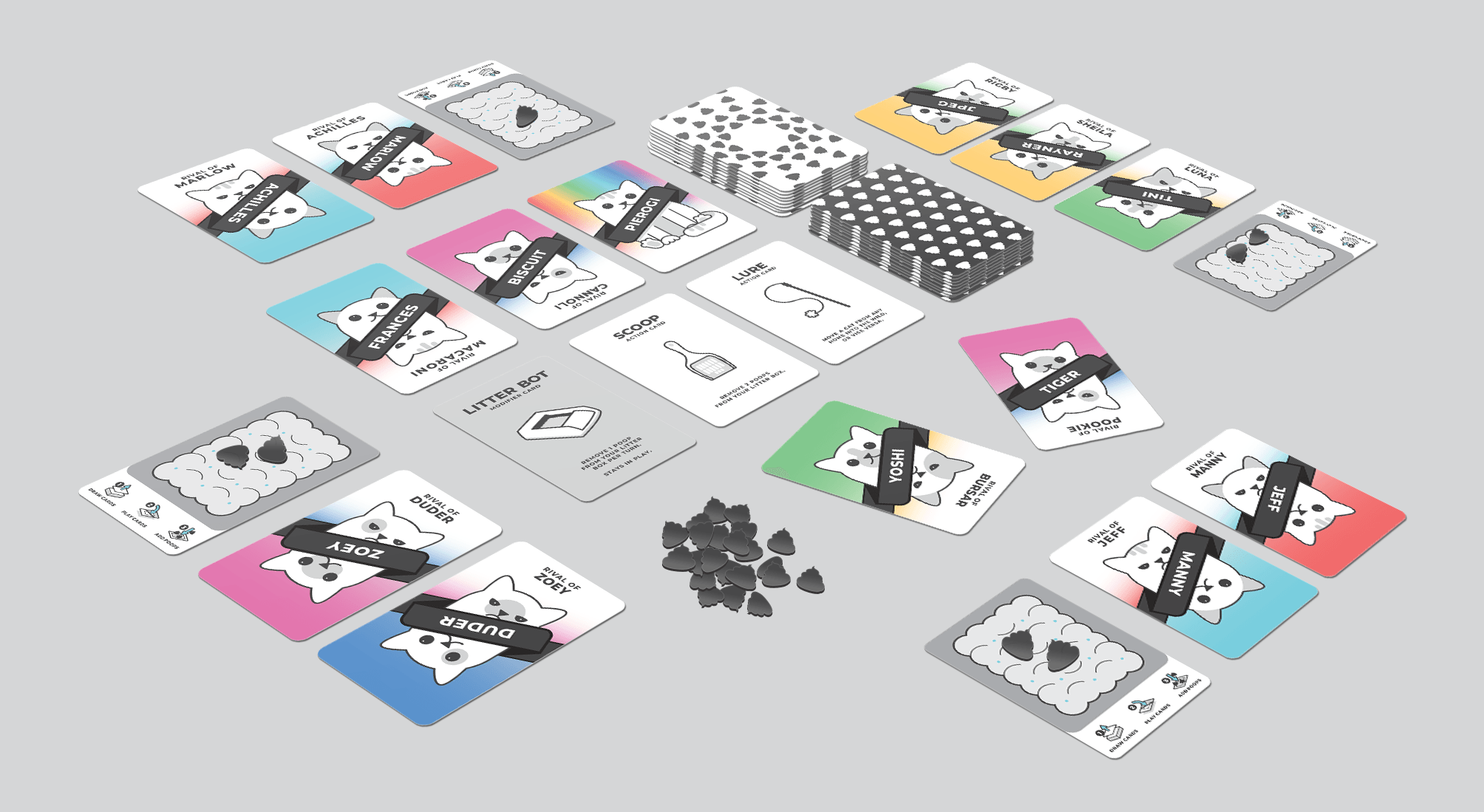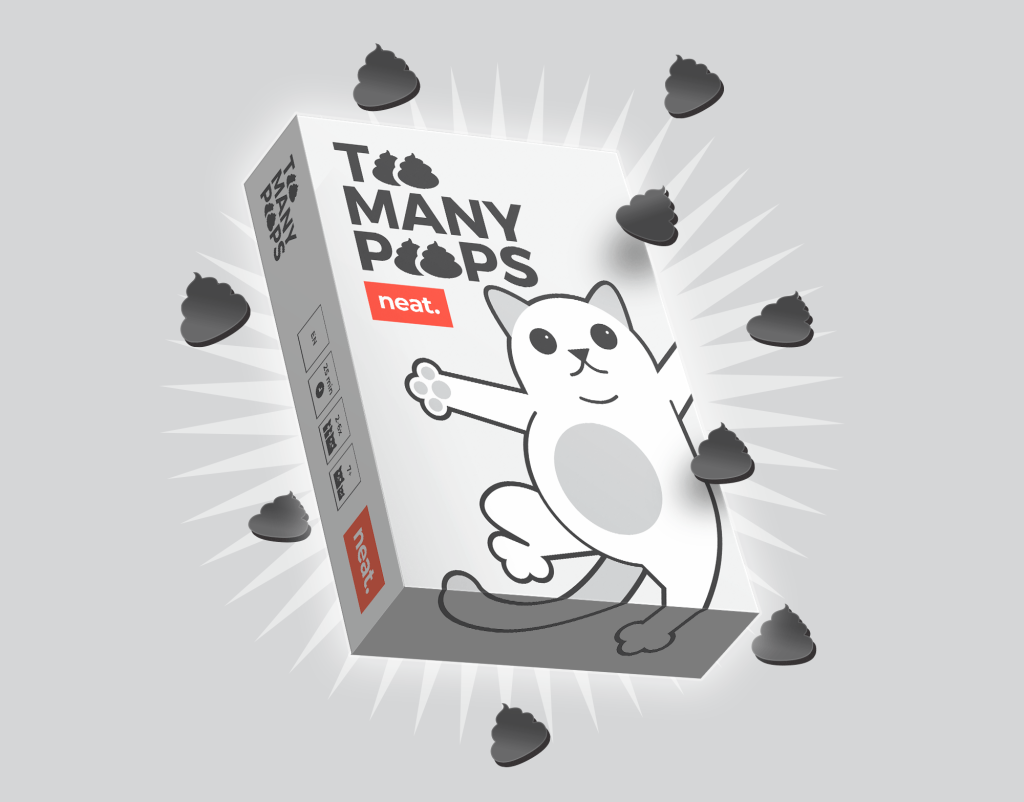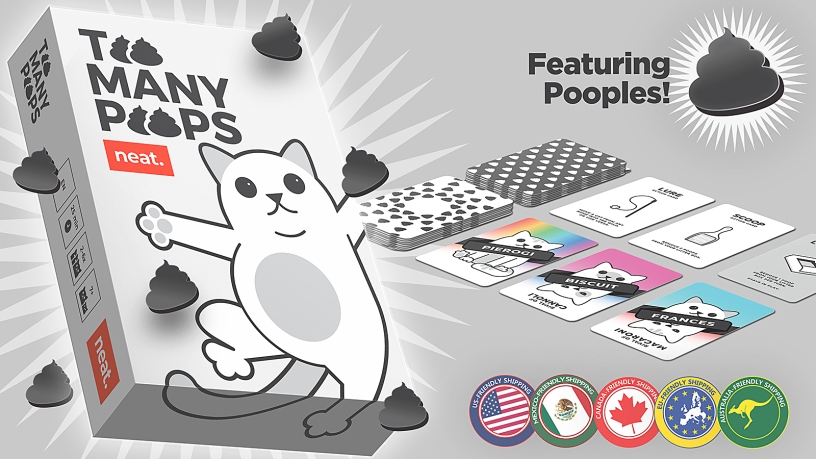Tell us a bit about yourself and Too many poops.
I’m Miguel Martinez and I co-designed Too Many Poops (TMP) with Aaron Burghard, who is the game’s original creator. A while ago a few of us from our game group confessed we were all wanting to design games, and Aaron mentioned he already had a game that he worked on and had shelved. He had a completely raw, vicious, and arguably very unbalanced 2P-only version of TMP. I immediately saw its potential (name, theme, innovative mechanics, etc.), pointed out all the things I thought needed to be fixed, and offered to help. I convinced Aaron for us to revamp his game entirely to play 4-6 players about two weeks before Gen Con in August 2018. We turned the game upside down and changed it dramatically. The game became a set collection game but leveraging some of the core ingenuity of Aaron’s design, like the rivalry system and theme-rich core player interactions. In the end the new version was a huge success at Gen Con. It was then that we decided we wanted to not just release TMP, but that we wanted to keep doing more projects like this. This was the start of our publishing studio, neat games.
What did you do to create a following for Too many poops before you launched?
We tried a lot of things but I would not say we actually were able to create “a following”. Social engagement is not our forte. We participated at a lot of events like Protospiels and some competitions, like the Logan Playtest Party which we won (and got us booth space at Chicago’s C2E2 in 2019, which is huge). But in reality these did not contribute much to our funding effort directly (e.g. mailing list) and there’s little to show for those referrals in our KS revenue. A lot of people swear by this slow “adding emails to your list through playtesting events” but the truth is your game is not going to be for everyone, so unless you’re going to very targeted events (e.g. you’ve got a strategy game and this is strategy con) it’s not worth the effort.
I realized we needed to make up for this deficiency somehow and I dug deep into learning about FB ads, which are a huge part of our current marketing strategy. I did a lot of experimentation through the months leading up to the campaign, and the result of this was a big leads list.
Unfortunately, as I describe later, we were not able to fully deploy this list and it was a huge missed opportunity. But although this lead gen was a big loss, we still leveraged our subscriber list (about 750 emails at that point) to create a base of lookalike audiences for our ongoing Facebook ads, which turned out to be hugely effective.
I would say most of our success was not because of a customer base we built beforehand, but one we created on the fly.

When did you launch and why did you choose that exact time?
We picked a Monday at 10AM CST. The time was guidance from Jamey Stegmaier’s articles, but I forgot that his recommendation (and one most follow) is for launch to be on a Tuesday instead. I personally always check KS on Mondays so was naturally inclined to think that was the day we should launch. By the time I realized I was wrong we had already announced our date on different forums and launch calendars.
This turned out working really well for us, however, since we spiked up on Monday enough to still be relevant Tuesday when all those eyes came looking for new projects — that’s why our Tuesday funding that week is much better than Monday.
Did you expect getting so many backers?
This whole project has been an experiment for us. We approached it assuming we would fund, but not by much, and that it would all be learnings. I expected our funding average to drop significantly on our third day, as most fund curves for projects do. I’m still amazed we’ve held a steady pace and every day think it’s going to drop.

If we take a look at your kicktraq graph we can see that it is highly unusual. You don´t have the normal curve and it seems that the number of new backers just keep on at a steady pace. What happened?
My take on this is mostly answered on the following question, but I think that’s only part of the equation. The other is that—even though it’s harder to observe the links in the data—there’s a strong perceived correlation between some of my strongest forms of referrals (e.g. facebook ads) with Kickstarter’s own platform referrals. So very simply for instance, if I drive more traffic to my project through ads then Kickstarter’s platform’s own referrals go up proportionally. I have very consistently observed this telegraphing throughout the campaign so far, down to the percentage.
The way I’ve come to think of this now is you’re turning this one gear, ads or promotion, which is in turn rotating all these other gears—Advanced Discovery, Category Discovery, Discovery Popular, Discovery Recommendations, etc. etc. It’s hard to quantify what my actual ROI is but the impact is there.
Why do you think Too many poops has become such a hit?
At a very high level I break this down into four things. 1) The name, theme (cats, not just poop), and the “pooples” are great enough to hook someone to dig a bit further; 2) the KS page is very well put together, especially that it immediately disarms your preconceived notion of this game (it’s not gross or disgusting, it’s lighthearted and cute—this is why we start our video with the infamous Ukulele song from BenSound); 3) our price is really good and hard to pass up — this is why even though we have a free print and play we’re seeing way more conversions on actual pledges (about 10% of our total backer count has downloaded our print and play, but there’s no way of knowing how many of those then converted immediately to backers); and 4) Facebook Ads. Plain and simple. Our ads are capitalizing on 1 through 3 so we’ve created a very effective funnel—hook, disarm, charm, pledge—and I’m constantly tweaking and optimizing them so it’s also a very cost-efficient conversion at this point.

If there was one thing you wish you knew before you launched, what would it be?
My biggest failure and biggest “aha!” moment throughout this project was banking heavily on a leads list we nurtured for months before launch but not having tested it way sooner than we did. I had assumed that I should only first engage with this list the day of launch so we wouldn’t lose subscribers so I left it alone. I realized the day before we launched the project in my launch prep that this meant it was a net new email for our subscribers. Because of this our emails hit a wall with spam filters, promotions tab, etc. and our open and click rates were abysmal.
My learning here is if you’re building a list you need to engage with it soon and often so your subscribers will whitelist you. This of course is it’s own other ball of mess with how you create value for your subscribers without overstaying your welcome.
What’s the best kickstarter advice you ever received?
I don’t think there was any I received directly but the one thing that spurred this for me that I try to instill in others is the spirit of empirical research. I’ve been in product development for years and have slowly migrated from far-removed consulting to boots-on-the-ground development and deployment of software products. There’s so many things that can actually go wrong when you build and test things. So although planning is great, you don’t really learn much from it. You learn by doing, and that’s what we set out to do in this project.
If you could change one thing with Kickstarter, what would it be?
Facebook conversion optimization. Understandably, Kickstarter doesn’t allow Facebook into their system. You can’t set a pixel anywhere to inform FB that someone converted (e.g. completed a pledge). This would obviously be a huge amount of very valuable data that KS would be giving up to FB. But from a creator POV and for the purpose of managing FB ads, this would be absolutely huge to have.
What do you think is the most important element of a Kickstarter page?
I had a hypothesis—which was confirmed by our google analytics—that a KS project is a huge funnel where people progressively drop off. It starts as soon as the video, which is why most complete rates are only about 50%. KS pages need to be structured almost entirely around this. The first few paragraphs of the page need to tell you, briefly, what the entire page is about. It’s the hook to get someone to dig deeper. This is also the only guarantee that you’ll be able to communicate these key points to the greatest number of people.
The way we did this in the TMP page is the first thing you see is a huge image of a play area, one paragraph description about the game and how it plays, then immediately we show awards and quotes, and all that’s included in the box. In a very brief scroll you have absolutely everything you would need to know if you are interested in this game.
Do you have any role models in the board gaming industry?
Well obviously James Mathe and Jamey Stegmaier. Mathe in particular, since his blog is just such a concentrated and matter-of-fact collection of data. He writes like he chimes in on FB: to the point and without any sugar coating. I think I learned everything I know about game publishing having spent almost a full day reading his blog while hanging out at a beach “on vacation”. And I constantly go back to refer to it.
Where can people reach you?
People can reach me about anything and with any questions (I’d be happy to talk more and at length about the project) at m@playneatgames.com

Really great info, enjoyed reading this. I have also been making the same assumption about waiting to send newsletter emails so your lesson learned is very valuable and just saved me from potentially making the same accidental mistake of waiting too long to prime the email list. Thanks!!
LikeLike
I was an early TMP backer, and the project caught my eye because it was clearly created very thoughtfully. Miguel and Aaron are also great writers and I loved that each update was entertaining, succinct and felt personal. And Pooples. 🙂
Congrats on a very successful launch, I can’t wait to get and play the game!
LikeLike